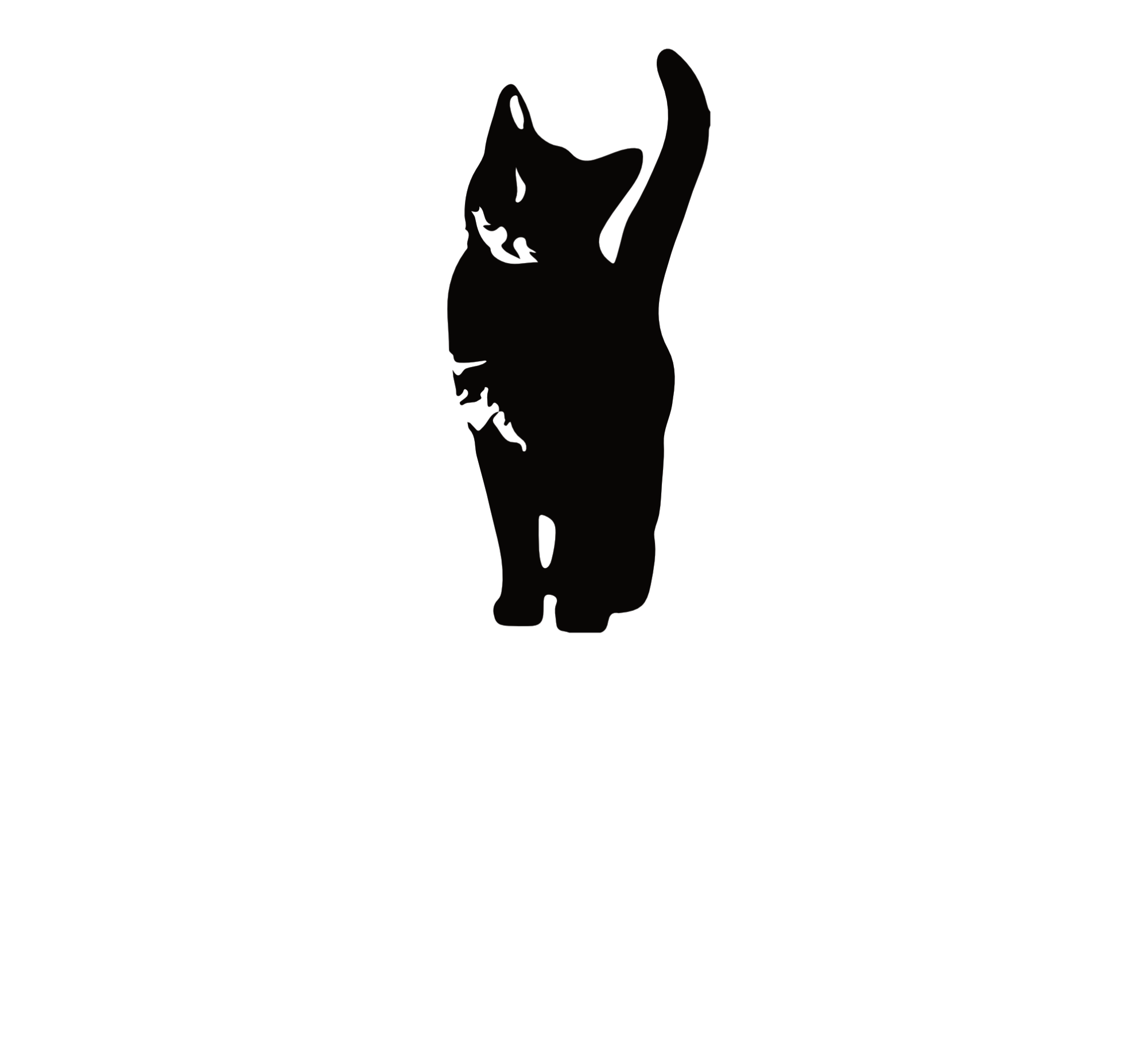The biggest failing of the market research industry over the last 100 years is in its impotency in exacting meaningful change. Sure, it has it wins here and there. It help deliver the World’s Most Interesting Man and apparently was integral to the conceptualization and launch of YouTube. But according to the 2019 Insight Practice Grid Report only 27% of research buyers are completely or very satisfied with “suppliers ability to recommend business actions based on the research”. That’s tied for dead last in satisfaction. Now read that again slowly. Ability to recommend. Not to do anything about the issue but even have the ability to recommend.
27%.
That’s horrible.
According to Greenbook the industry was about $29 billion dollars in total size in 2019. Does that mean the industry wasted $21 billion dollars on in-actionable research? Maybe.
The good news is it doesn’t have to be that way.
Over the years I have collected, learned, and refined some useful techniques that can help increase the odds of your insights to be used. Below is a rough roadmap.
1. Clearly define what you are trying to solve
You can’t achieve a goal if you don’t know what it is. I have waxed on about this topic ad nauseum so I won’t spent too much time here. Needless to say; defining the problem is job one. I have found the Dr. Leticia Bristos Cavagnaro’s “stakeholder >needs >insight” tool to be immensely helpful in that endeavor. Here’s a simple example from a mass transit project we worked on a few years ago.
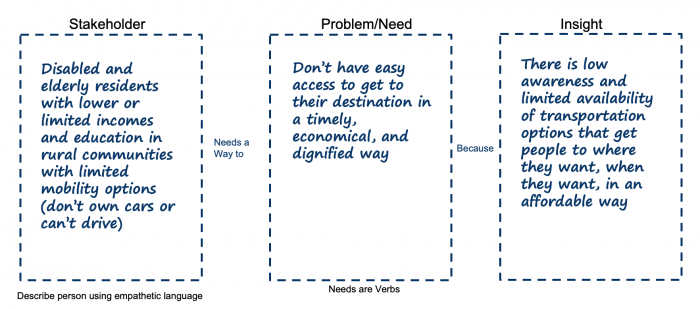
First, we start with the customer. Who are we designing this solution for? Many times engineers design stuff for engineers and don’t always take into account the customer. This helps get some focus on the end user and other stakeholders.
Second, what are we trying to solve? This can seem straight forward until you start thinking about it. In this example it wasn’t just moving people around, it was getting them to and from their doctor’s office without having the indignity of waiting for hours in a waiting room to be picked up.
Finally, we put the two together to get the insight. Presto. This is a great time to argue and debate. Albert Einstein once said, “If I had had an hour to solve a problem I’d spend 55 minutes thinking about the problem and 5 minutes thinking about solution”.
Einstein was a smart dude. Get to your problem statement and get alignment on that before going any further. You can’t solve what you haven’t defined and agreed upon as the problem.
2. Bring Everyone Along
Never view your initiative as a “research project”. Research projects are done by the market research group and get ignored or discarded. They are nice to knows in many cases. You are working on a change effort and, in the case of CX, that is usually an organizational change effort.
Second, get people involved from day one. The worst-case scenario is the client writes a check, the supplier does market research, and then the supplier presents a 60 minute PowerPoint while everyone checks out their Facebook and Instagram feeds.. That’s a recipe for certain failure. Avoid that.
First, as the CX leader or researcher you need to get very invested. Not so invested you lose your objectivity but invested in the domain to be investigated. I have done projects on everything thing from candy to luxury yachts. Lawn tractor tires fascinated me. I learned all about elevators and holiday light sets. Get interested. Get invested. Get curious. If you can’t, you probably need to pass on that project.
You also need other team members invested and participating in the project. The most successful projects I have ever worked on are ones where 1) where there is a very high level of engagement from all stakeholders on the client side 2) there is a relationship of trust and respect between team members (this means client and supplier side), 3) where there are clear roles defined, and 4) there was an implicit or explicit expectation that change would be the outcome of the project.
One way to make sure this happens is holding sessions that aren’t just customer feedback report outs but also problem definition, creation, and testing phases. As the CX or Insights person, you don’t need to quarterback everything. Tag others in as you manage the process. Nothing pulls a team together like a common goal of building something
3. Create Stuff
So, you spent a bunch of time finding out what customers want and what the problem is, now it’s time to solve it. It’s time to create. The fun stuff. It’s also the stuff that makes people super nervous. Nervous about exposing their own brand of crazy on the world or anxious they aren’t creative. Pfft. Nonsense.
Everyone can be creative. It’s not only the domain of guys with sleeve tattoos and purple hair who can doodle like Degas. You just need to give people a chance to be the wonderfully true weirdos they all are. Some people feel that being creative is the frivolous domain of children. It is. But without creativity, we would still be living in holes in the earth and eating bugs with a long stick for breakfast. No one wants to eat bugs for breakfast.
Creativity (and of course the associated curiosity) is what defines us a unique species. We are the only species that can improve on the solutions of others. The best other animals can do is let the ones who can’t adapt die off. Rather than adapting to our environment…we change our environment instead.
The tools you use to get creative isn’t super important. There are many great brainstorming platforms…but essentially all you need is a platform where you can ideally 1) see each other 2) talk to one another and 3) have a place to doodle and put ideas down collaboratively. I recently have been using Mural. It has a bunch of great features like voting and timers and is pretty intuitive to newbies…but there are many others as well.
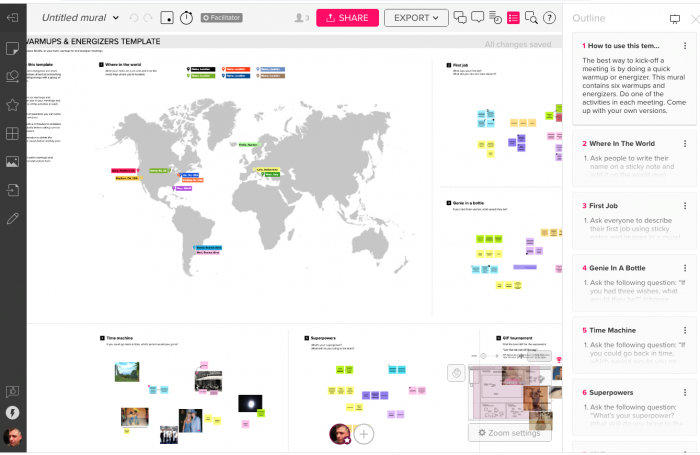
4. Build Stuff
Now it’s time to take it over the hump of where most traditional market researchers get a bit nervous. Building stuff. This is clearly out of the traditional domain of the voice of the customer and market research, but there is no reason why the research team shouldn’t be front and center and this is a mandatory role for any CX leader to be involved with.
In this stage you start developing concepts. These concepts can vary in their fidelity from sketches and “paper prototypes” to working prototypes. The goal here is to start to get real. I had my students create all kinds of zany stuff using cardboard and plastic borrowed from milk cartons. They felt silly at first but then really got into it.
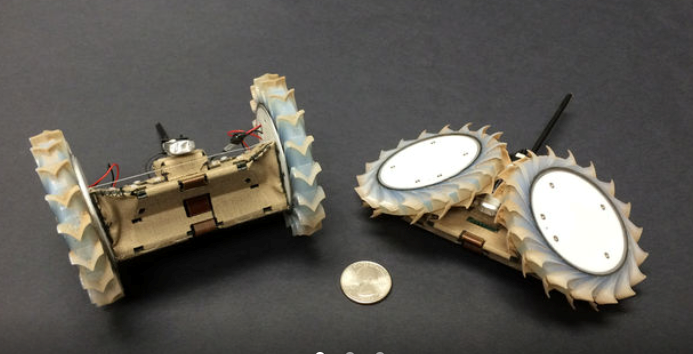
Even rocket scientists regard low fidelity prototypes as serious business. For example, NASA and JPL created a collapsible robot scout paper prototype inspired by Origami.
I prefer to use a storyboard approach before going to prototype. They are cheaper, quicker to make, and relatively easy to alter. They are also very portable. The other nice thing about storyboards is… well you can tell a story.
In the Cohen brothers film The Hudsucker Proxy, the mailroom-entrepreneur-wanna-be protagonist Norvell Barnes had a great idea for a new innovative product. Excited to share his great invention he would sketch it out on a napkin and show to people.
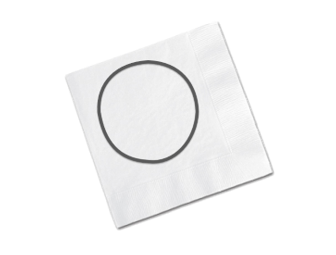
It looked like this
He would smile and say then “you know, for kids”. Every thought him to be insane hayseed from Muncy, Indiana. His lack of connection stemmed from sharing how it was used and from whom it was for. Norvell’s invention was a Hola Hoop and it went on to be smashing success for the fictitious Hudsucker Industries. Folks “get” innovations when provided context of why they would be useful. As a species we have been telling stories long before we could read or write, so it is an intuitive way to communicate information quickly.
There is also a reason why humans started adding graffiti to cave walls long before writing…we are an extremely visual species. Studies reveal that more than 50% of the cortex is devoted to processing visual information. In writing and reading, there is a fair amount of encoding and decoding that must occur. This places more of a cognitive load on the viewer and is just…well…harder. Seeing pictures interpreting information much easier. That’s why kids generally prefer comic books to regular old boring books.
Making Story Boards
The first step in making a storyboard is to create a narrative. I usually do this by creating two columns. The first column is the “dialog” and the second is labeled “visual” and I list a suggested picture or scene to show. If you have even a little bit of drawing talent (I don’t) you can do it yourself.
At Curiosity we are blessed in having a cadre of incredibly talented folks who can make something that is presentable for customers to view. The finished product is usually 3 – 8 pane storyboard. There are a variety of choices from black and white sketch to the use of vector graphics. We have also on occasion done short videos and animations for more complex concepts that require 3D or movement.
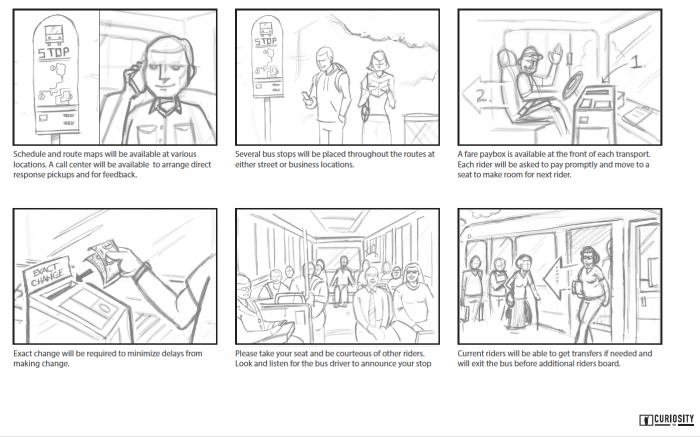
4. Test Stuff
With your prototypes and/or storyboards in tow, it’s now time to test stuff with real customers. Please don’t just use your buddies, they won’t want to spend to the social capital to tell your ideas stinks. Worse yet, your buddies are probably similar to you and may like your ideas just for that reason.
For that reason, it’s important to go out and do some actual research. For concept development I generally recommend a qualitative route…if you are fairly far along on refinement you can also move to quantitative, especially if you are testing smaller variations or require a “bake off” of concepts. This approach can cost anywhere from a few thousand bucks up to hundreds of thousands depending on what and how many things you are testing.
If you can’t afford more formal and rigorous market research, you should minimally go out and do a bit of field research with users. I find when designers get in touch with the end users something magic happens; empathy. They start to understand what their end users want.
Famed electric guitar inventor Les Paul knew what guitarists wanted because he was one, albeit one with a bit of vision where he could take it. Leon Fender, on the other hand, couldn’t play a note. But he hung out with a ton of guitarists and he listened very closely. He made a damn fine guitar (and in fact beat Gibson to the punch in launching a successful electric guitar).
5. Refine
If you are of a particular age you will remember the first mobile phones. They were large, had very little battery life, worked in only certain areas, and the fidelity was quite poor. In short; they sucked. However, if we didn’t have those, then flip phones, then Blackberry’s and iPhones gradually evolving over the years we wouldn’t have the pleasure of our kids complaining how they can’t stream YouTube videos for more than 8 hours on their phone on a single charge. Products and services like species evolve over time. Sometimes that evolution is gradual and sometimes it is discontinuous, but it is always a journey…usually one of two steps forward and one back.
Getting Away from Reports
When I was on the client-side, I remember a supplier asking me “so how many pages should the report be”? I knew then, I didn’t want that company doing my reports. That “research by the pound’ mentality is thankfully less prevalent today than in the past but persists in some of the more remote bywaters of the market research industry.
It’s time for the industry to evolve. Those in the CX and Insights business need to move away from viewing themselves as passive collectors and disseminators of information. First, we need to get better at communicating (also tied for last in the Greenbook report at 27% somewhat or very satisfied amongst insight buyers). Large boring text-heavy reports with no narrative or story are dead. More visual and dynamic reporting is now required. People like beautiful things. Make your information beautiful.
Second, and more importantly, the industry needs to move to a more active stance as creative change agents armed with data. Otherwise, we are going continue lack of efficacy and a loss of interest in customer insight, not because it isn’t relevant, but because nothing is done with it.
I am optimistic. Design thinking and agile approaches such as the ones I reviewed here on are on the rise in practice. More forward-thinking creative agencies are starting to invest in data and strategists versus just fulfillment. Likewise, some emerging boutique research firms are also crossing the aisle to engage in brainstorming in prototyping versus just slinging data on both supplier and client-side. I think this is a great step forward and hope to see it continue.
